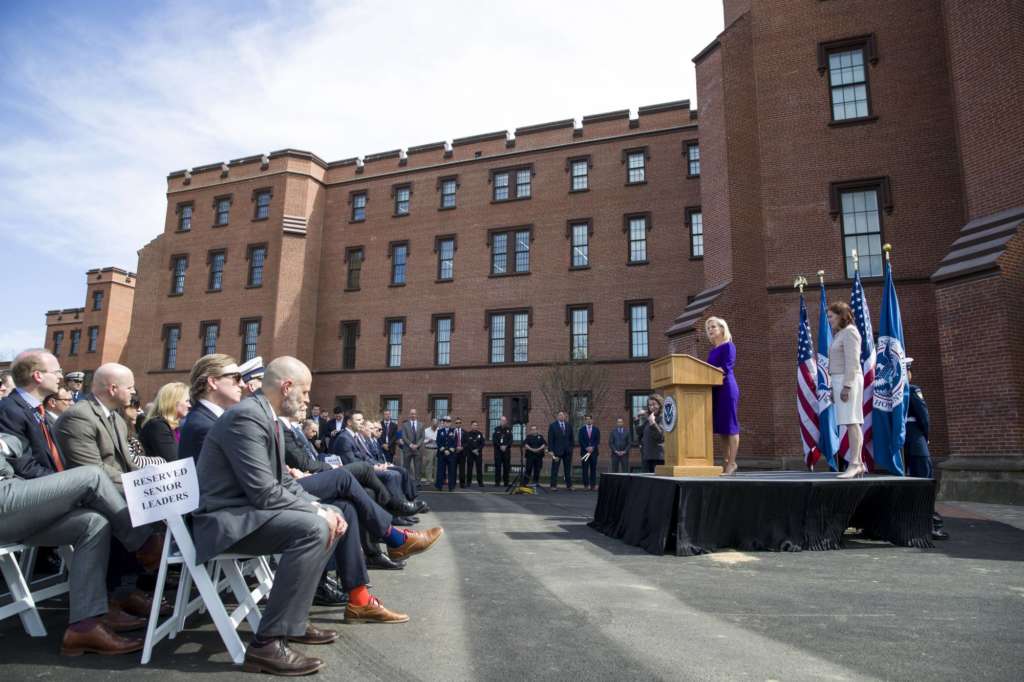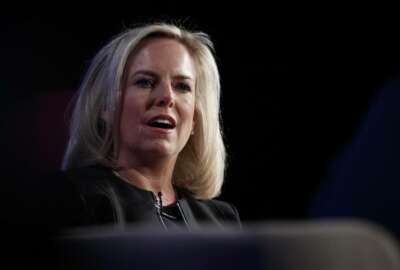
Hubbard Radio Washington DC, LLC. All rights reserved. This website is not intended for users located within the European Economic Area.
Hubbard Radio Washington DC, LLC. All rights reserved. This website is not intended for users located within the European Economic Area.
The St. Elizabeths campus now houses senior DHS management officials, but the ongoing project still serves as a reminder that the agency faces an uphill battle ...
Best listening experience is on Chrome, Firefox or Safari. Subscribe to Federal Drive’s daily audio interviews on Apple Podcasts or PodcastOne.
On April 10, her final day as secretary of the Department of Homeland Security, Kirstjen Nielsen stood alongside her acting successor, Kevin McAleenan, and former undersecretary for management Claire Grady, and held a ribbon-cutting ceremony at the Center Building of the agency’s St. Elizabeths campus.
Located across the Anacostia River in Southeast Washington, the St. Elizabeths campus now houses senior DHS management officials, but the ongoing project still serves as a reminder that the agency faces an uphill battle when it comes to functioning like a unified agency — an issue it’s faced since Congress cobbled together 22 existing organizations more than 15 years ago.
Nielsen, in a speech last month, called the St. Elizabeths project the biggest federal construction project since the Pentagon. Construction of the Pentagon, however, only took 16 months, while the St. Elizabeths project will be completed by 2026 — more than a decade after the project began — according to another departing official, Chip Fulghum, the agency’s deputy undersecretary for management.
Bradley Saull, vice president for civilian agencies at the Professional Services Council, recalled promising developments and construction efforts underway during a meeting on the campus last week, but in an interview, expressed doubts that the project could go on as a unified DHS headquarters as previously envisioned.

“It has been disappointing to see that the St. Elizabeths campus has continued to run into financial headwinds, and it’s not going to, in the end, result in the kind of the complete unit unification of DHS as it was originally intended to do,” said Saull, who worked as a staff member on the House Homeland Security Committee. “Certainly not everybody who works at the Department of Defense works at the Pentagon, but having that sense of unity and headquarters in place is certainly very important.”
Several interviews and the results of a Federal News Network survey show that current and former DHS employees, as well as the agency’s partners in the private sector and elsewhere in the government, feel the recent shakeups in DHS leadership — with at least 12 top positions either vacant or temporarily held by acting officials — has put an added strain on the agency’s ability to communicate as one agency and mitigate management issues that date back to its creation.
The current challenges with the St. E’s campus is an ongoing example of why the leadership vacuum is concerning.
Chris Currie, the director of emergency management and national preparedness issues at the Government Accountability Office, said the “holistic planning” of the St. E’s campus remains a top concern, especially considering that a revised master plan for the campus now is two years late.
While the General Services Administration and DHS expect to submit a new draft master plan to the National Capital Planning Commission before the end of this year, some recent details have emerged.
Instead of moving FEMA to the St. E’s campus next, Fulghum told lawmakers earlier this month that DHS now intends to move the Cybersecurity and Infrastructure Security Agency (CISA). And despite longstanding efforts to preserve historic buildings on the St. E’s campus, GSA and DHS have proposed demolishing as many as five historic buildings and constructing three new ones.

It’s unclear without permanent leadership whether that master plan will be further delayed.
As a project that’s run both behind schedule and over budget, St. E’s stands out as a case study of why DHS’s management of acquisitions and finances both remain on GAO’s high-risk list.
Marc Pearl, president and CEO of the Homeland Security & Defense Business Council, said the “constant flux” of acting officials and vacant positions at DHS has led to the contracting community questioning what return on investment they can expect doing business with the agency.
“Too many of my members have said that they don’t know what’s going to be down the road, how long it’s going to take to get people on-boarded, how much training is going into the people that are program managers and contracting officers,” Pearl said. “If you are just simply getting your job done from day-to-day and pushing the pieces on the chessboard, you’re not going to think strategically. If you’re not going to think strategically, you’re not going to be able to think innovatively, of changing processes or thinking about doing something differently.”
Jim Williams, a former DHS and GSA executive and now a partner with Schambach and Williams Consulting, said having good acting leaders in place at agency components will play a significant role in ensuring continuity of effort, but acting leaders, knowing their tenure is limited, will likely hold off making any major management decisions in this capacity.
“Those executives in acting roles are more risk-averse, generally speaking, but it also depends on the person,” Williams said. “If they are confident in their abilities, they are maybe more likely to get things done. They have to enjoy the confidence of the political leaders further up the chain.”
While the contracting community points to a probable lack of management decisions under acting leadership as a troubling situation, rank-and-file employees see that stasis as an indication that their day-to-day responsibilities will remain unchanged.
While 81% of respondents to an exclusive online survey of Federal News Network readers who self-identified as DHS employees said they were either very worried or somewhat worried by the shakeup in DHS leadership, those respondents were evenly split over whether recent leadership changes and vacancies have impacted their day-to-day work in recent weeks, or whether the turnover has impacted employee morale.
A survey respondent said acting personnel often feel reticent to make changes that will ultimately impact their successor.
“No one in an ‘acting’ role feels comfortable making long-term plans or commitments. The lights stay on when agency or departmental leadership is in transition, but time and progress are lost on many fronts,” the respondent wrote.
A DHS employee who requested anonymity to discuss the shakeup in DHS leadership said the agency’s “C-suite” leadership will keep the momentum going on current agency initiatives.
“Yes, change is a tad disruptive, but I do not see us missing a beat. We have a strong CXO leadership team and they know what their job is and how to keep the mission going forward. We are taking the changes in stride and waiting for our bosses to tell us if there is a change of direction,” the employee said.
In addition, 69% of respondents said the shakeup would impact DHS’s ability to retain top talent, while 59% said those conditions would make it harder to attract new talent to the agency.
Despite DHS showing recent improvements in the annual Federal Employee Viewpoint Survey, Currie said the agency is basically in the same place with respect to morale as they were in 2010.
“We still don’t feel good enough about the progress and the morale issues of DHS to say that they’ve fully addressed those issues,” Currie said.
One survey respondent feared younger talent would leave the agency because of instability, lack of clear promotion paths and “an uncertain future.”
However, other respondents said the mission of their component agency has remained unchanged, and expect the mission to attract new talent.
“We are a law enforcement agency. If we continue to appeal to people who believe in our mission, we will get some of the best people. However, we have to be able to communicate that to the public as well,” the respondent said.
Pearl said the shakeup in DHS leadership probably won’t have an impact on the agency’s operations on the front lines, but he added that it would have some influence on the management of policy and programs from headquarters in Washington.
“If you don’t know who the person is that you’re supposed to call, and you’re in the same department as that person, it takes extra time, it takes extra energy,” Pearl said.
While C-suite leadership and immediate supervisors set the day-to-day tone at component agencies, top DHS political leadership wind up setting budget priorities for the agency as a whole, and defend their budget requests — and cuts — before lawmakers on Capitol Hill.
“The leaders are ones that are going to be making decisions about the acquisition programs and the budgets ultimately, so if they don’t have the best information on the success and the progress these acquisitions and from the centralized processes, then it’s going to make already very difficult decisions that much harder for them,” Currie said.
While the president’s budget request sets a $51.7 billion budget for DHS — more than a $10 billion increase from 2017 enacted levels — those increases aren’t spread evenly across the various components. The Transportation Security Administration, for example, has nearly a flat budget request at $7.8 billion.
“As we like to say at the department, flat is the new up,” acting deputy TSA administrator Patty Cogswell said Tuesday at a panel at American University’s School of Public Affairs. “So the fact that we did not get cut is a really good sign.”
And when the Senate does confirm new permanent leadership at DHS, those officials will set their own top-level priorities, based on their background and expertise.
Under Nielsen’s tenure, DHS convinced lawmakers to rename the National Protection and Programs Directorate to CISA. Chris Krebs, CISA’s director, has often credited Nielsen in the past with elevating DHS’s cybersecurity mission. However, one survey respondent said the agency still lacks a broader mission statement.
“CISA should be getting more focus from Congress other than name changes or reorgs,” one respondent wrote. “Fundamentally, what is it we do?”
However, Federal Chief Information Security Officer Grant Schneider, speaking at an April 16 Intelligence and National Security Alliance (INSA) event, said CISA still has a “solid team” in place, and has a strong sense of its mission going forward, thanks to the National Cybersecurity Strategy and DHS’s own cyber strategy it released last summer.
“I think they’ve got some good guideposts that the department can work off of, so I’m not actually concerned [about] the level of focus inside the department,” Schneider said.
Despite the recent shake-up in leadership, House Homeland Security Committee Chairman Bennie Thompson (D-Miss.), in an April 10 letter, said he expects McAleenan to testify at a hearing that Nielsen had agreed to appear at.
“With a majority of the senior leadership and component head positions at DHS vacant or run by acting officials, this is no way to run the department,” Thompson said in a statement to Federal News Network. “The president cannot run this critical national security and safety agency with whomever he chooses to instill. The department will quickly need proven, Senate-confirmed leaders in place that can work with Congress in good faith to help keep the country safe.”
Rep. Mike Rogers (R-Ala.), the committee’s ranking member, added in a statement that McAleenan’s role as acting secretary serves as “an important signal that border security is one of the president’s top priorities,” but still called on President Donald Trump to fill the current gaps in permanent leadership.
Senate Homeland Security and Government Affairs Committee Chairman Ron Johnson (R-Wis.) echoed concerns about border security in a statement, but added that he urged Congress and the president to fill a “growing leadership void” within the department and address “some of the most significant problems facing the nation.”
While it remains unclear whether the president intends to nominate McAleenan or acting DHS Deputy Secretary David Pekoske to serve on a permanent basis, Saull noted one potential bright spot, if either official returns to their previous posts at Customs and Border Protection or TSA.
“They could be better component leaders potentially as a result of their time at the department’s headquarters,” Saull said. “From a human capital perspective, those job rotations — not only at the leadership level, but in other parts of the organization — I think are also very helpful into contributing to a happier workforce that really is more collaborative and strengthens the capabilities of the department.”
Copyright © 2024 Federal News Network. All rights reserved. This website is not intended for users located within the European Economic Area.
Jory Heckman is a reporter at Federal News Network covering U.S. Postal Service, IRS, big data and technology issues.
Follow @jheckmanWFED
